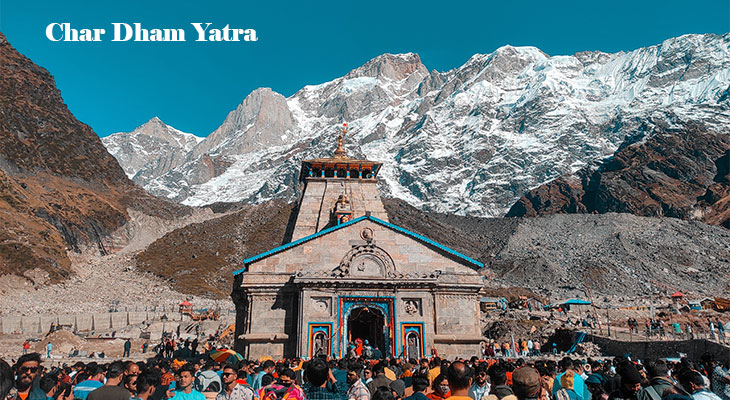
The Char Dham Yatra tour package is a popular pilgrimage for Hindus in India. It is comprised of four sacred places in Uttarakhand - Yamunotri, Gangotri, Kedarnath, and Badrinath - known as "Dhams," or abodes of God. The portals of Char Dhams open every summer from April to May, and this year, the yatra will begin on April 30, 2025, with Yamunotri and Gangotri Dham opening on the same day. Kedarnath Dham will open on May 02, 2025 (tentative), and Badrinath Dham will open on May 04, 2025 (tentative). The Official date of Chardham Yatra is announced every year well in advance, allowing people to prepare for the journey with ease. A well-prepared itinerary for the Char Dham tour package from Delhi is available below the dates. This itinerary can be customized from Mumbai and Haridwar as well.
To know "How to register for Char Dham Yatra in 2025?, check out this link.
Kind Attention: It is mandatory for every pilgrim who desires to undertake this sacred pilgrimage to complete the "online registration process" before commencing the Yatra.
Char Dham Yatra Opening and Closing Dates
20 Important tips for Char Dham Yatra
Char Dham Tour Package from Delhi
DAY 01 : DELHI – HARIDWAR BY ROAD 200 KMS 05 HOURS
Haridwar : Haridwar is not just a city, it's a portal to divinity. A mystical gateway to the gods, where the name itself, derived from the words "Hari" meaning God and "Dwar" meaning gate, signifies the grandeur of this place. It's the starting point of the revered Char Dham yatra, where pilgrims embark on a spiritual journey to the four sacred shrines of Yamunotri, Gangotri, Kedarnath, and Badrinath in the Garhwal Himalayas.
Situated at the foothills of the majestic Shivalik range in the Garhwal Himalayas, Haridwar has a history that spans back to ancient times. It is the place where the holy river Ganges touches the plains and where countless temples, ashrams, and holy sites abound. The air resonates with the enchanting sounds of Vedic hymns and the pious chants of saints clad in saffron attire, as they perform intricate rituals on the Ghats of the Ganges.
Haridwar is not just a place of religious significance; it's a hub of learning, culture, and Ayurvedic medicine. This charming city is renowned for its Ayurvedic medicines and herbal remedies, which have been used for centuries to promote healing and wellbeing. A visit to Haridwar is a journey of self-discovery, where one can immerse oneself in the rich culture and history of this mystical city, and experience the wonder and awe of the divine.
As one of the most ancient pilgrimage sites, Haridwar is at the foothills of the Shivalik range in the Garhwal Himalayas. Haridwar is a place where the holy river Ganges touches the plains. Haridwar has a lot to offer like countless temples, Ashrams, divine sounds of Vedic hymns, and a group of saints in saffron clothes performing rituals on the Ghats of the holy river the Gange.
Apart from religious importance, Haridwar is also a center for learning different arts and cultures. Haridwar is well known as a great source of Ayurvedic medicines and herbal remedies.
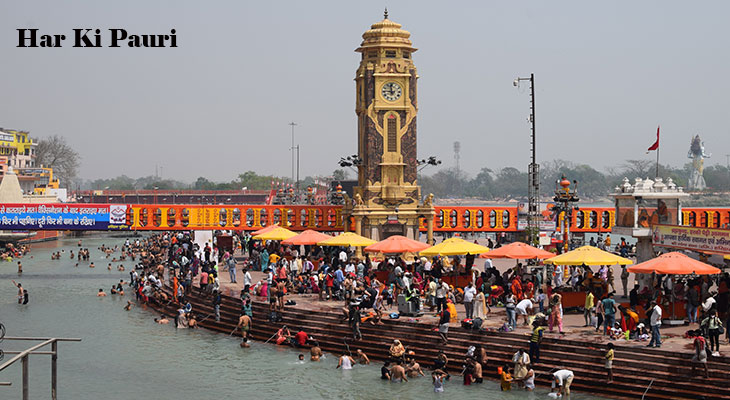
Har-Ki-Pauri: Har-Ki-Pauri is not just a holy Ghat; it's a place of mystical wonder and divine blessings. Every twelve years, Kumbh Mela occurs here, drawing crowds from across the country to partake in the sacred festivities. Every six years, Ardh Kumbh is held here, adding to the enchanting aura of this place. According to legend, drops of Amrit (Elixir) fell into the Brahmkund at Har-Ki-Pauri, making it one of the most sacred Ghats in Haridwar.
The holy Ganga flowing through the Himalayas touches the plain for the first time at Har-Ki-Pauri, making it a sacred site for devotees seeking blessings from the divine. The Ghat attracts devotees in large numbers, who come here to offer their prayers and seek the blessings of the holy river. The mere act of taking a dip in the Ganges here is said to wash away all sins, offering a sense of purification and renewal to those who partake.
The Ghat is also home to a remarkable wonder - a mark of Lord Vishnu's footprint on a stone, serving as a reminder of the divine presence that permeates this place. Har-Ki-Pauri is a testament to the power and majesty of the divine, and a place of unmatched spiritual significance.
Ganga Aarti (Ganges Ceremony): The Ganges Aarti ceremony at Har Ki Pauri ghat is an ethereal experience that must not be missed. Every evening, between 6 pm to 7 pm, a group of priests perform this sacred ritual, where the river Ganges is worshiped for providing life-giving water to mankind for centuries.
The atmosphere is charged with spirituality as the air fills with the divine music of Vedic hymns and chants. You can offer earthen diyas in a floral bowl to the river, becoming a part of this mystical ceremony. The flickering lights and the rhythmic sounds of the Aarti create a mesmerizing ambiance, transcending the physical world and taking you to a higher plane of existence.
To witness the Ganga Aarti is to experience a moment of pure serenity and transcendence, connecting with the divine in a way that's difficult to describe in words. It's a chance to be a part of something truly unique and powerful, and a testament to the enduring spirit of faith and devotion that drives the human spirit.
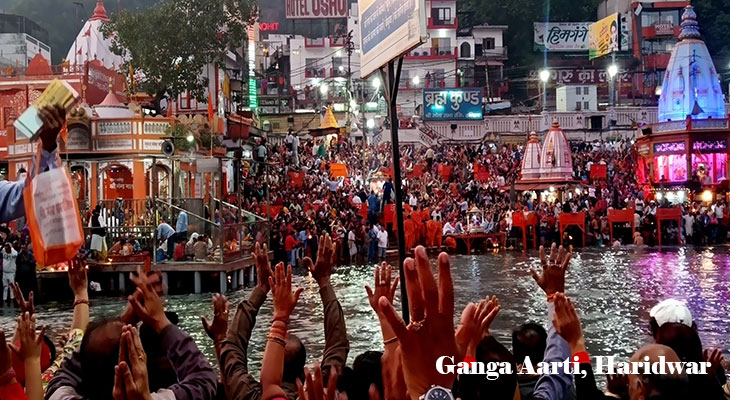
Shopping in Haridwar : Shopping in Haridwar is an experience that is truly unique, offering visitors the chance to explore a wide range of items that reflect the city's deep spirituality and religious heritage. As you stroll through the narrow streets and alleys around the Ghats, you'll find numerous shops selling an array of goods that are sure to pique your interest.
From precious gems and stones to sacred Rudraksha beads, there's something for everyone in Haridwar. You'll also find a variety of intricately crafted idols, paintings, and other religious artifacts that are sure to capture your attention. The city is particularly famous for its range of Ayurvedic medicines and herbal remedies, which are widely used for their healing properties.
The shops here are more than just places to buy souvenirs - they are a reflection of the deep spiritual culture and traditions that are an integral part of the city. Each item is imbued with meaning and significance, making it a cherished memento of your visit to this sacred place. So, whether you're looking for a special gift or a unique keepsake, Haridwar is the perfect place to indulge in some retail therapy while immersing yourself in the city's rich cultural heritage.
Mansa Devi Temple: The Mansa Devi Temple is a majestic shrine perched atop the Bilwa Parvat hillock in the Shivalik ranges of the Himalayas. Dedicated to the Hindu goddess Mansa Devi, this temple is a revered pilgrimage site for devotees from all over the world. It is believed that if you tie a piece of thread on the tree located in the temple complex and return to untie it after your wishes have been fulfilled, the goddess will grant your wishes.
The temple offers stunning panoramic views of the surrounding mountains, making it a must-visit destination for nature lovers and spiritual seekers alike. The temple can be reached by using the ropeway facilities, which offer a thrilling ride through the lush green forests that surround the temple.
As you explore the temple complex, you'll be captivated by the intricate carvings and beautiful architecture that adorn the temple. The serene atmosphere and the divine presence of the goddess Mansa Devi make this temple an ideal place for meditation and spiritual contemplation.
Whether you're seeking divine blessings or simply looking to soak in the natural beauty of the region, a visit to the Mansa Devi Temple is an experience that will stay with you for a lifetime. So come, tie your thread and make your wishes, and bask in the peaceful ambiance of this holy shrine nestled amidst the majestic Himalayas.
Chandi Devi temple: Perched atop the Neel Parvat of the Sivalik hills, lies the magnificent Chandi Devi temple in the holy city of Haridwar. This ancient temple, dedicated to the powerful Hindu goddess Chandi Devi, is said to have been built in the 8th century A.D by the revered saint Adi Shankaracharya. According to legend, the goddess was formed from the cells of Goddess Parvathi to defeat the demon kings Shumbh and Nishumbh. Visitors can choose to reach the temple either by embarking on a scenic trek or by taking the convenient ropeway facilities. The Chandi Devi temple is truly a divine experience not to be missed.
DAY 02 : HARIDWAR - KHARSALI (280 KM/ 08 HRS DRIVE)
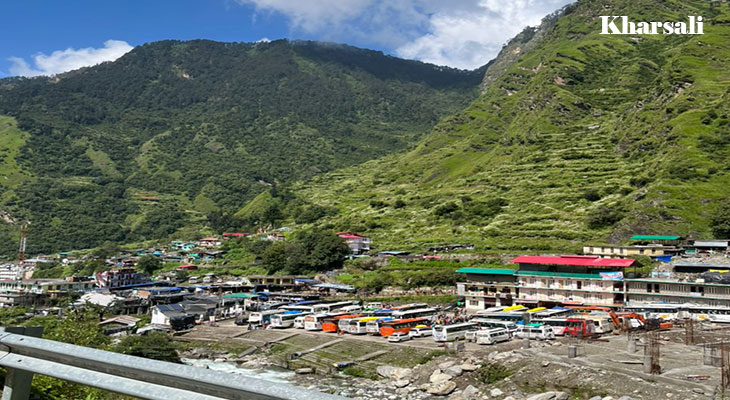 Kharsali is a scenic and peaceful village nestled in the lap of the Garhwal Himalayas, located in the Uttarkashi district of Uttarakhand. It serves as the base camp for the Yamunotri trek, one of the most important and revered pilgrimages of the Char Dham Yatra. The village is surrounded by lush green forests and offers stunning views of the snow-capped peaks of the Himalayas.
Kharsali is a scenic and peaceful village nestled in the lap of the Garhwal Himalayas, located in the Uttarkashi district of Uttarakhand. It serves as the base camp for the Yamunotri trek, one of the most important and revered pilgrimages of the Char Dham Yatra. The village is surrounded by lush green forests and offers stunning views of the snow-capped peaks of the Himalayas.
DAY 03 : KHARSALI – YAMUNOTRI – KHARSALI 05 KMS TREK ONE SIDE
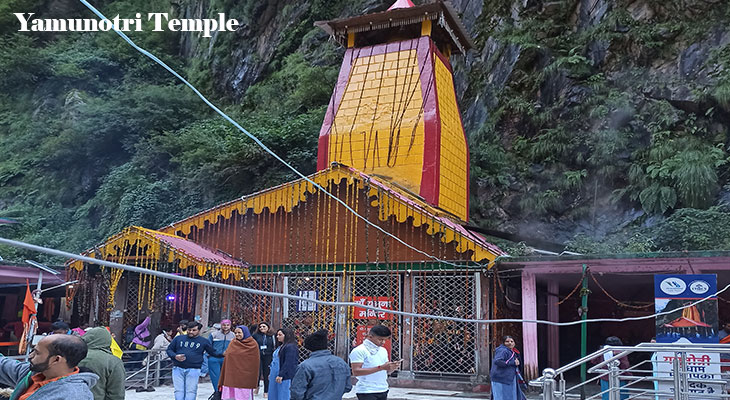
Hanuman Chatti: Hanuman Chatti is a scenic location situated at the confluence of Hanuman Ganga and Yamuna River. It is a popular stopover point for pilgrims en route to Yamunotri. The place is surrounded by beautiful mountains and lush green forests, making it a perfect spot to relax and admire the beauty of nature. Apart from its natural beauty, Hanuman Chatti also holds religious significance as it is believed that Lord Hanuman rested here during his journey to Lanka to rescue Sita.
Yamunotri Temple: The Yamunotri Temple is a significant pilgrimage site and the first stop of the Char Dham Yatra, dedicated to the Goddess Yamuna. The temple was built by Maharani Gularia of Jaipur in the 19th century but was destroyed twice and rebuilt again. Nestled in the picturesque Garhwal Himalayas of Uttarakhand, the temple is situated at a breathtaking altitude of 3,165 meters above sea level. The temple is not only a place of worship but also the source of the sacred river Yamuna, which originates from the Champasar Glacier. The serene and tranquil environment surrounding the temple adds to the spiritual experience of the devotees.
Surya Kund: Surya Kund is a significant thermal spring located in the vicinity of the Yamunotri Temple. The hot water from the spring flows into several pools, making it a popular spot for pilgrims to take a dip before entering the temple. The most important of these pools is the Surya Kund, which is believed to have medicinal properties and is said to have the power to cure various ailments. The water temperature in Surya Kund is very high and can reach up to 190°F (88°C). It is considered auspicious to cook rice and potatoes in the hot water of the Kund before offering it to the deity.
Divya Shila: Divya Shila is a sacred rock pillar located near the Yamunotri Temple in Uttarakhand. It is worshipped by the devotees before entering the temple as it is believed to be a symbol of Lord Shiva's eternal power. The pillar is made of black stone and is considered as a divine rock that fulfills the wishes of the devotees. The significance of Divya Shila lies in the fact that it has been standing there for centuries, untouched by the harsh weather and natural calamities, signifying the eternal power of the divine.
DAY 04 : KHARSALI – UTTARKASHI (137 KM / 06 HRS DRIVE)
Uttarkashi: Uttarkashi is a town located in the Uttarkashi district of the Indian state of Uttarakhand. It is situated on the banks of river Bhagirathi and is known for its rich cultural heritage and religious significance. The town is surrounded by the majestic Himalayan peaks and is a popular destination for adventure enthusiasts and pilgrims alike.
One of the major attractions of Uttarkashi is the ancient temple of Lord Vishwanath, which is located on the banks of the river Bhagirathi. The temple is considered to be one of the most sacred shrines in the region and is visited by thousands of devotees every year. The temple is also home to an iron trident, which is said to be one of the most powerful symbols of Lord Shiva.
Apart from the Vishwanath temple, Uttarkashi is also home to several other important temples such as Ekadash Rudra, Bhairav, Gyaneshwar, and Goddess Kuteti Devi. These temples are known for their unique architecture and religious significance.
Uttarkashi is also a popular base camp for several treks and expeditions in the region. The town is surrounded by several trekking trails that lead to some of the most beautiful and remote parts of the Himalayas. Trekking enthusiasts can embark on treks to Dodital, Dayara Bugyal, and Nachiketa Tal, among others.
Overall, Uttarkashi is a must-visit destination for those seeking a blend of spirituality and adventure in the lap of the Himalayas.
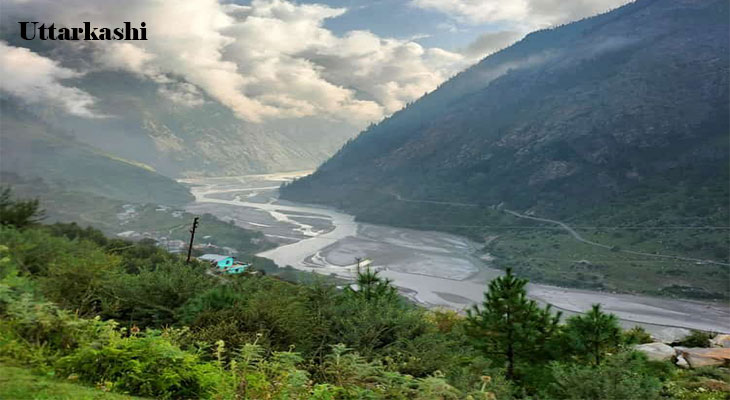
DAY 05 : UTTARKASHI – GANGOTRI – UTTARKASHI (200 KM / 07 HRS DRIVE)
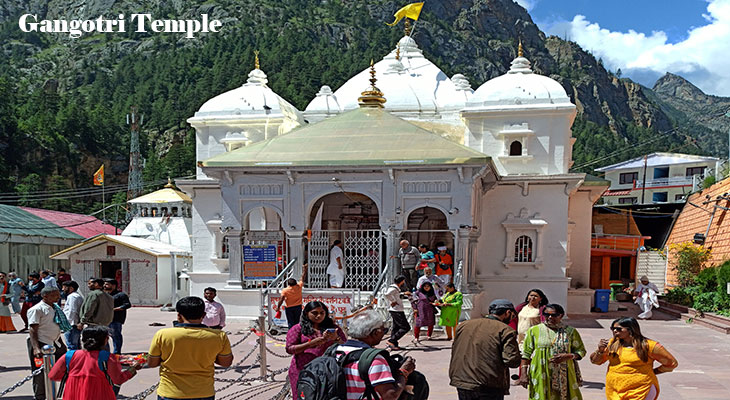
Gangotri Temple: Nestled amidst the majestic Garhwal Himalayas, the Gangotri Temple stands tall and proud, beckoning to the faithful to embark on a spiritual journey like no other. This revered temple, located at an altitude of 3,042 meters, is an epitome of divine grandeur and exquisiteness, dedicated to the holiest river of India, the Ganges.
Legend has it that the river Ganga descended to the earth to cleanse the souls of the mortals, and this is where she first touched the earth. The temple, built by the valiant Gorkha Commander Amar Singh Thapa in the 18th Century, is a stunning white granite structure, with intricate carvings and elaborate architecture that leave visitors in awe.
As you enter the hallowed precincts of the temple, you can feel an indescribable sense of serenity and spirituality engulf you. The gushing waters of the Bhagirathi river, on whose right bank the temple stands, add to the mystical charm of the place. The temple is dedicated to the revered Goddess Ganga, who is personified here as the embodiment of purity and divinity, and worshipped with great reverence by the devotees who come from far and wide.
A visit to the Gangotri Temple is nothing short of a transcendental experience, one that will leave an indelible imprint on your soul.
Submerged Shivling: Nestled amidst the rippling waters of the holy Ganges, lies a mystical marvel - the Submerged Shivling, a natural rock formation that stands as a testimony to the legends of Lord Shiva. As the tale goes, it is the very spot where the mighty Lord Shiva sat, as he received the holy river Ganga in his matted locks, cascading down from the heavens. The Shivling remains hidden beneath the river's surface for most of the year, revealing itself only during the winter months when the water level recedes, inviting devotees to catch a glimpse of its sacred glory.
Kedar Ganga Sangam: A serene confluence where the mighty Bhagirathi and the sacred Kedar Ganga merge, creating a breathtaking sight of powerful currents and tranquil waters. Flowing from the Kedar Valley, the Kedar Ganga joins the Bhagirathi on its left bank, around 100 yards from the revered Ganga Temple. The site is not only a scenic wonder but also a significant place for spiritual seekers, offering a rare opportunity to immerse oneself in the divinity of the holy rivers.
DAY 06 : UTTARKASHI - SITAPUR VIA GUPTKASHI (175 KM / 08 HRS DRIVE)
DAY 07 : SITAPUR – SONPRAYAG – GAURIKUND - KEDARNATH (22 KM TREKIKING ONE SIDE)
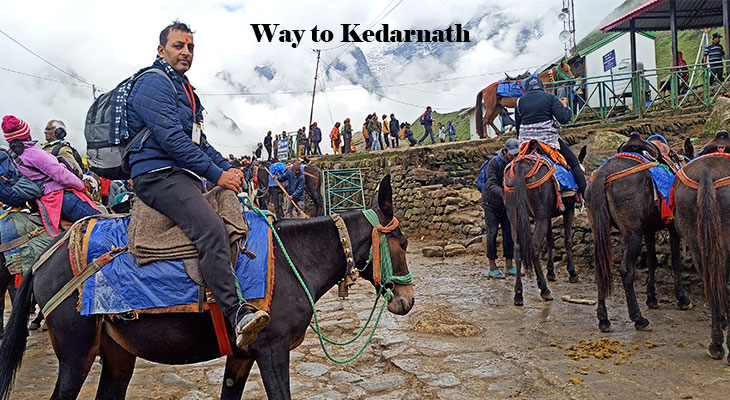
Gaurikund: Gaurikund is a mystical destination located just 5 kilometers away from Sonprayag, at an altitude of 1982 meters. This enchanting place is steeped in Hindu mythology and is considered a sacred site by devotees. Here, one can take a refreshing dip in the hot water pond, believed to have medicinal properties, and visit the revered Gauri Temple.
According to legend, it is said that Goddess Parvathi meditated here to win the affection of Lord Shiva, and hence the place is named after her. Gaurikund also serves as the starting point for the 22 km trek to Kedarnath, one of the four holy shrines of the Char Dham Yatra. The serene and peaceful surroundings of Gaurikund make it an ideal place for spiritual seekers and nature enthusiasts alike.
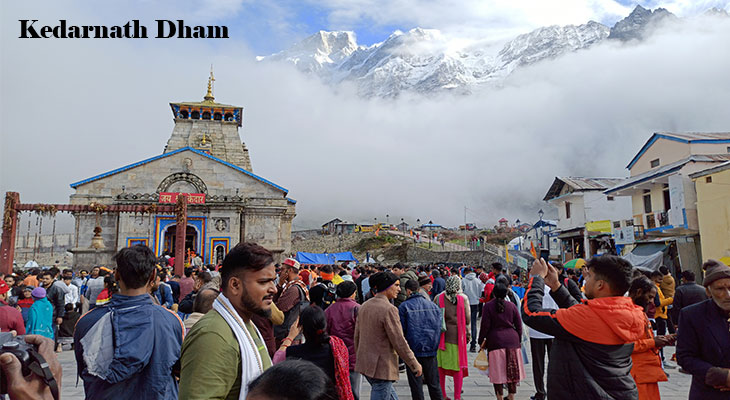
Kedarnath: Kedarnath, a magnificent shrine situated in the picturesque Kedarnath range, is considered to be one of the most revered Jyotirlingas of Lord Shiva. The name "Kedar" itself symbolizes Lord Shiva, the protector, and the destroyer. According to the ancient legend, after the Mahabharata war, the Pandavas were consumed with guilt for killing their own kin and sought redemption from Lord Shiva. However, Lord Shiva, elusive as ever, evaded them at every turn. Eventually, he took the form of a bull and sought refuge in Kedarnath. As the Pandavas followed him, he plunged into the ground, leaving behind his hump on the surface. The other body parts of Lord Shiva manifested themselves at Tungnath, Rudranath, Madhmaheshwar, and Kalpeshwar, and collectively, these five shrines are known as Panch Kedar. Kedarnath, with its awe-inspiring beauty and rich mythological history, is truly a sight to behold.
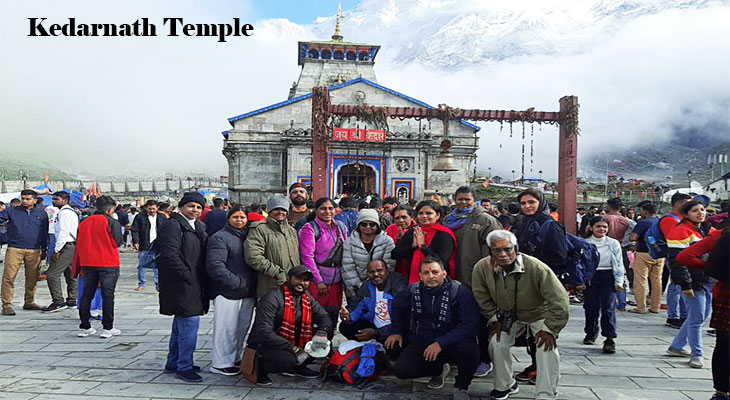
Bhim Shila : Bhim Shila, a massive rock located behind the Kedarnath temple, played a crucial role in protecting the temple from the devastating floods that hit the region in June 2013. According to legend, it is believed that the rock was placed there by Bhima, one of the Pandava brothers, during their quest to seek Lord Shiva's blessings. The rock is said to have been placed there to protect the temple from any natural calamities.
During the floods, the Mandakini river, which flows behind the temple, swelled up and caused massive destruction in the area. However, the Bhim Shila acted as a barrier and prevented the floodwater from damaging the temple. It is considered a miraculous event that the temple survived the calamity, and many believe that it was due to the power of the Bhim Shila.
Today, the Bhim Shila is a significant attraction for pilgrims visiting the Kedarnath temple, and many pay their respects to the rock as a symbol of protection and divine intervention.
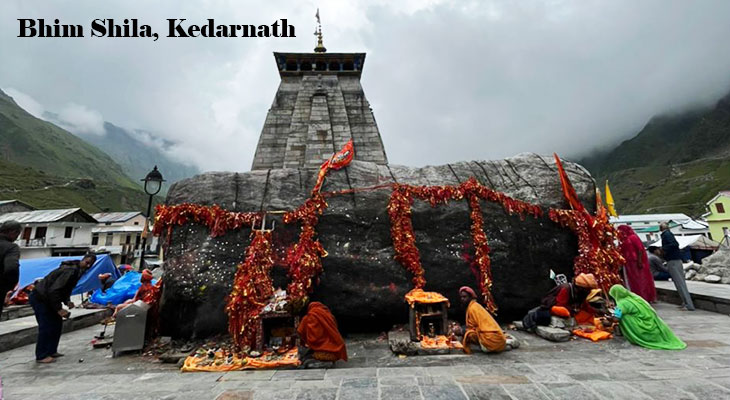
DAY 08 : KEDARNATH – SITAPUR – TRIYUGINARAYAN – UKHIMATH (40 KM 2 HRS DRIVE)
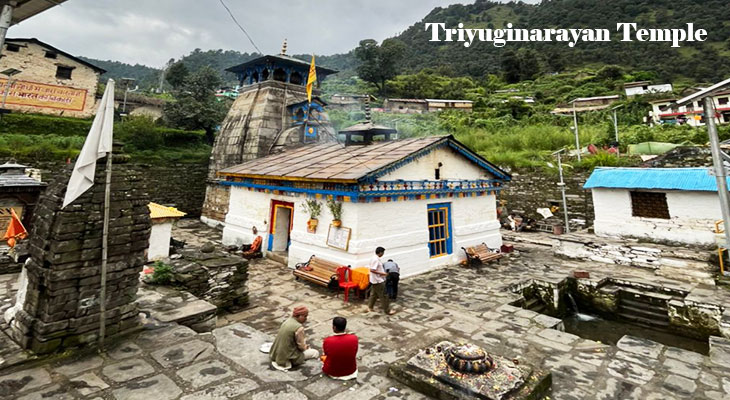
Triyuginarayan Temple: Triyuginarayan Temple is a sacred Hindu temple located in the village of Triyuginarayan in Uttarakhand, India. The temple is devoted to Lord Vishnu and is known for the divine marriage of Lord Shiva and Goddess Parvati, which is believed to have taken place here. The temple is also famous for the perpetual fire that burns in front of it, which has been burning since the time of the divine marriage. The temple is also known as the Akhand Dhuni temple because of the presence of this flame.
The temple complex also has three sacred bathing ponds or kunds, which are filled by a stream flowing from the temple courtyard. This adds to the spiritual significance of the place and makes it a popular pilgrimage site for Hindus.
After visiting Triyuginarayan, you will drive towards Ukhimath. It is a small town located at an elevation of 1,311 meters and is around 41 kilometers from Rudraprayag. Ukhimath is known for being the winter home for the Utsava idols of Kedarnath Temple and Madhyamaheshwar Temple, which are worshipped here for six months. You will check in at your pre-booked hotel in Ukhimath and enjoy dinner and an overnight stay.
DAY 09 : UKHIMATH – TUNGNATH – BADRINATH (150 KM 7 HRS DRIVE)
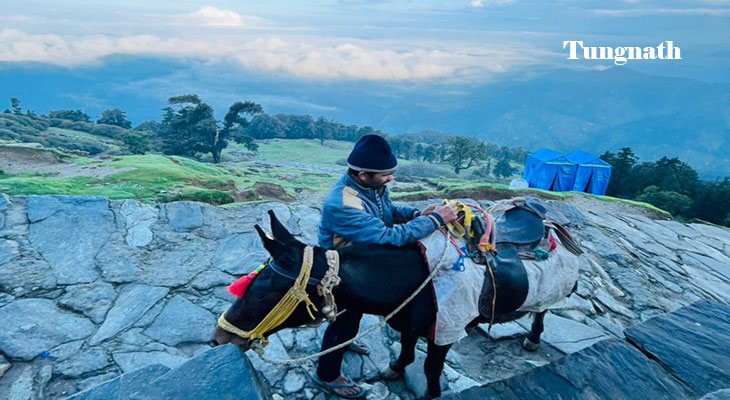
Tungnath : The Tungnath Shiva Temple is one of the oldest and highest Shiva temples in the world. Tungnath Temple, also known as the "Lord of Peaks," is a significant pilgrimage destination for Hindus. It is believed to be 1000 years old and was constructed during the Gupta dynasty. The trek to Tungnath begins from Chopta, which is a picturesque hamlet located at an altitude of 2680 meters above sea level. The trek is around 4 km long and takes around 2-3 hours to complete.
The path is well-defined and goes through lush green forests of rhododendron and oak trees. As you climb higher, the scenery becomes more and more breathtaking, with stunning views of the surrounding Himalayan peaks. Once you reach the temple, you can take in the awe-inspiring views of the mountains, which include some of the highest peaks in India, such as Nanda Devi and Trishul.
The temple architecture is typical of the region, with a small wooden structure and a stone foundation. The inner sanctum houses a black stone idol of Lord Shiva, and the walls are adorned with beautiful carvings and paintings. It is said that the Pandavas, the heroes of the Indian epic Mahabharata, built the temple during their exile.
Tungnath is also the starting point for the trek to Chandrashila peak, which offers spectacular panoramic views of the Himalayas. It is a popular destination for adventure enthusiasts and nature lovers. The best time to visit Tungnath is between April and November, as the temple remains closed during the winter months due to heavy snowfall.
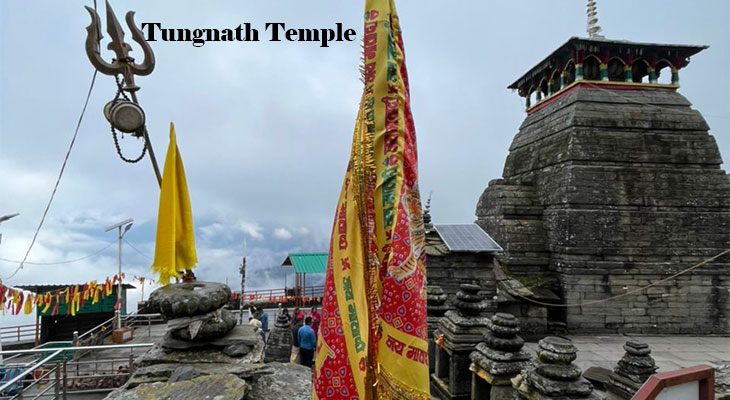 After Tungnath, continue drive to Badrinath via Joshimath. On arrival in Badrinath, Check in at hotel. Badrinath is sacred Hindu pilgrimage, a small town, located at an elevation of 3300 mts on the banks of river Alaknanda in Uttarakhand, India. Badrinath is one of the four Dhams and most sacred place, guarded on either side by the two mountain ranges known as Nar & Narayan with the towering Neelkanth Peak providing a splendid backdrop. Visit Badrinath temple. . Pilgrims after having a bath in the Taptkund, go for Darshan of Badrivishal & Aarti in the evening.
After Tungnath, continue drive to Badrinath via Joshimath. On arrival in Badrinath, Check in at hotel. Badrinath is sacred Hindu pilgrimage, a small town, located at an elevation of 3300 mts on the banks of river Alaknanda in Uttarakhand, India. Badrinath is one of the four Dhams and most sacred place, guarded on either side by the two mountain ranges known as Nar & Narayan with the towering Neelkanth Peak providing a splendid backdrop. Visit Badrinath temple. . Pilgrims after having a bath in the Taptkund, go for Darshan of Badrivishal & Aarti in the evening.
Return to hotel for dinner and overnight.
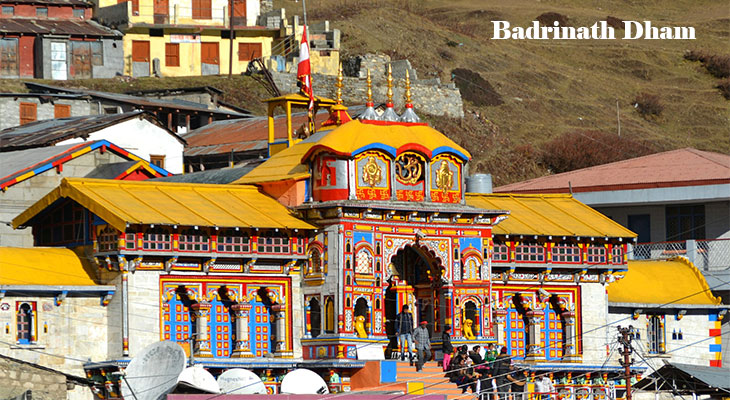
Badrinath temple: The Badrinath Temple is situated on the bank of the river Alaknanda at the Garhwal Himalaya region in Uttarakhand state. The Badrinath temple is an important pilgrimage site for Hindus and attracts a large number of devotees from all over the world. The temple is open for visitors from April to November every year, as it remains covered in snow during the winter months. The idol of Lord Badrinath is made of black stone, and it is believed to be a self-manifested statue. The temple is surrounded by snow-capped mountains, and the picturesque view of the surroundings is a treat to the eyes.
The Badrinath Temple is also associated with various legends and myths. According to one legend, Lord Vishnu meditated at this place for several years, standing on one leg. Impressed by his devotion, Goddess Lakshmi took the form of a Badri tree to provide him with shade. Another popular legend is that Adi Shankara found a black stone image of Lord Badrinarayan in the Alaknanda River, and he established the temple at this site.
Apart from the temple, there are several other attractions in Badrinath, such as the Mana village, which is the last inhabited village before the Mana Pass leading to Tibet. The Vasudhara Falls, which is a trek away from Badrinath, is a beautiful waterfall that is said to have the power to wash away sins. The Charanpaduka Temple, located on a rock, is believed to be the place where Lord Vishnu left his footprints. The Neelkanth peak, which is visible from the temple, is a popular trekking spot.
Overall, the Badrinath Temple is a must-visit destination for those seeking spiritual solace and a glimpse of the rich Hindu culture and mythology.
DAY 10 : BADRINATH – MANA VILLAGE – BIRAHI (85 KM 2 HRS DRIVE)
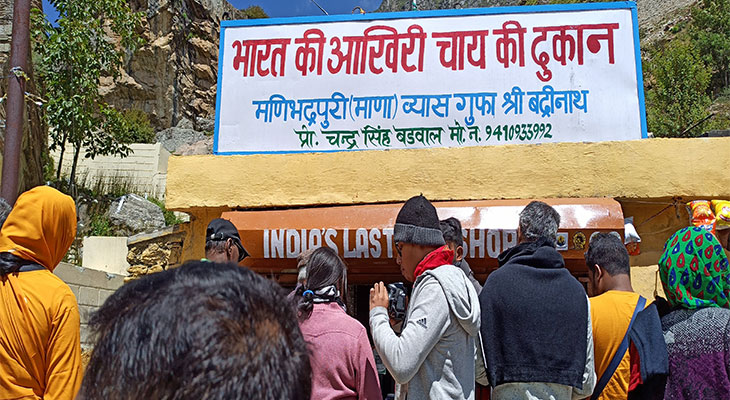
Mana Village: Mana is the last Indian village from the border of India and Tibet/China in the Himalayas. Mana Village is an important pilgrimage site for Hindus due to its association with the epic Mahabharata. The village is believed to be the place where the Pandavas, the heroes of the Mahabharata, ascended to heaven. There are several places in Mana village associated with the Pandavas, such as Vyasa Gufa, where Maharishi Ved Vyasa is said to have narrated the Mahabharata to Lord Ganesha who wrote it down, and the Vyas Gufa, where he is believed to have meditated.
Other important sites in Mana village include the Bheem Pul, a natural bridge over the Saraswati River believed to have been constructed by the Pandava prince Bheem, and the Ganesh Gufa, a cave where Lord Ganesha is believed to have lived while writing the Mahabharata.
Apart from its religious significance, Mana village is also known for its natural beauty and is a popular trekking destination. Visitors can also enjoy local cuisine, handicrafts, and cultural performances. The village is accessible by road and can be visited as a day trip from Badrinath or as a stopover on the way to the Mana Pass, which leads to Tibet.
The epic Mahabharatha was told by Maharishi Ved Vyasa in this village, and Ganesha penned the entire story. Besides caves, the Sarasvati river, temples, etc., you can also see several related sites mentioned in Hindu scriptures.
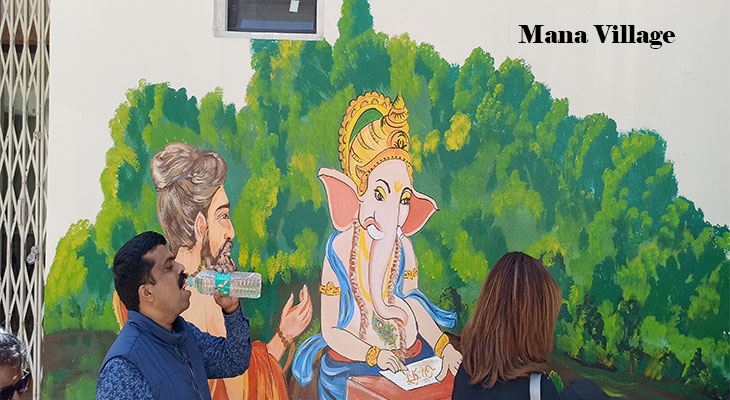 Besides religious sites, some trails encourage adventure seekers to plan treks & hikes and explore the region at their own pace.
Besides religious sites, some trails encourage adventure seekers to plan treks & hikes and explore the region at their own pace.
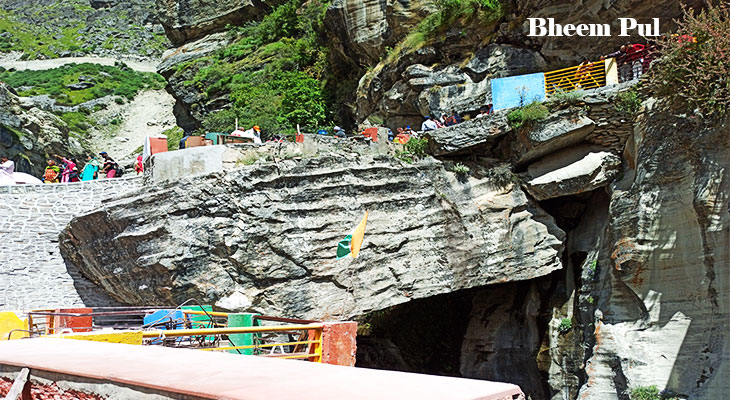 After the sightseeing of Indian last village Mana, continue drive down and stop at place called Birahi. Upon arrival in Birahi, check in at your resort. Today is free day for relax. Dinner and overnight stay at resort.
After the sightseeing of Indian last village Mana, continue drive down and stop at place called Birahi. Upon arrival in Birahi, check in at your resort. Today is free day for relax. Dinner and overnight stay at resort.
DAY 11: BIRAHI – DHARI DEVI - DEVPRAYAG - RISHIKESH (140 KM 5 HRS DRIVE)
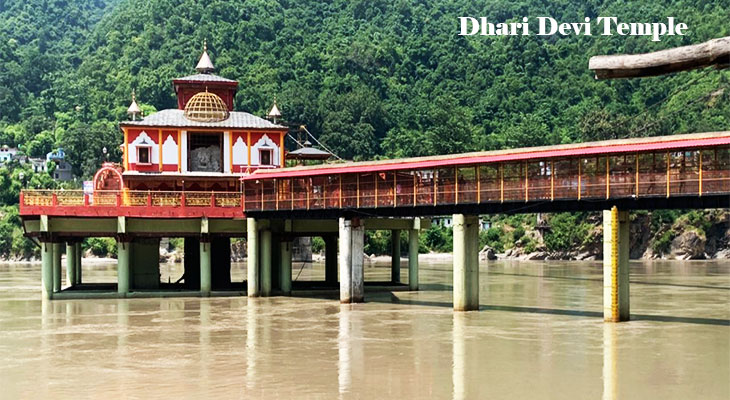
Dhari Devi Temple: We will begin our journey to Rishikesh after breakfast from Birahi, with the famous Dhari Devi temple as our first stop along the Badrinath Highway, situated 13 km before Srinagar Garhwal. The temple is situated on the banks of the river Alaknanda and houses the upper half of the idol of goddess Dhari. Her lower half is worshipped as a manifestation of Kali in Kalimath.
However, due to the construction of the Srinagar Hydropower Project, the Dhari Devi temple had to be relocated from its original rock-based site. In 2013, this pilgrimage site was moved from a rock 20 meters high to a man-made structure. The temple holds immense importance in Uttarakhand as it is believed that Goddess Ire caused the devastating floods in 2013. As Dhari Devi is the guardian deity of Uttarakhand and protector of the Char Dhams, the locals consider the temple as a sacred site for seeking blessings and protection.
After visiting Dhari Devi temple, countinue drive to Rishikesh via visiting Dev Prayag.
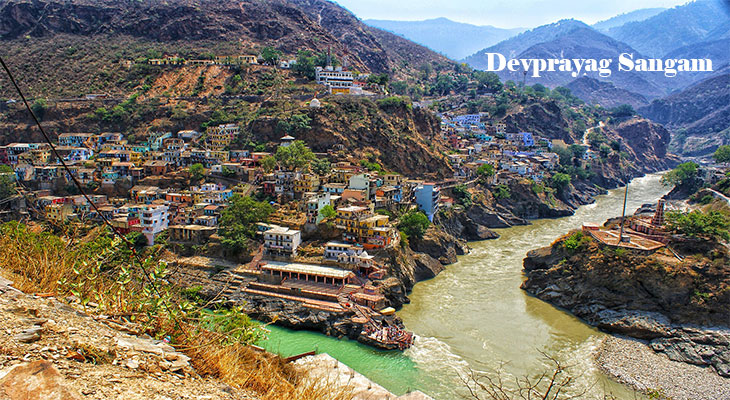
Devprayag : Devprayag is a town located at an elevation of 472 meters, where two of the most sacred rivers of India, Bhagirathi and Alaknanda, converge to form the mighty Ganga river. This confluence is considered to be a highly revered pilgrimage site among Hindus, who come here to take a dip in the holy waters and seek blessings. The town is also home to the famous Raghunathji Temple, dedicated to Lord Rama. Devprayag is one of the Panch Prayag, which refers to the five sacred confluences of the Alaknanda River. Later continue drive towards Rishikesh.
Upon your arrival in Rishikesh, you will check in at your pre-booked hotel. After refreshing yourself, you will visit to witness the Ganga Aarti in the evening. Rishikesh has several ghats where the Ganga Aarti takes place, but the Parmarth Niketan and Triveni Ghat are among the most famous. Later, you will return to your hotel for dinner and overnight stay.
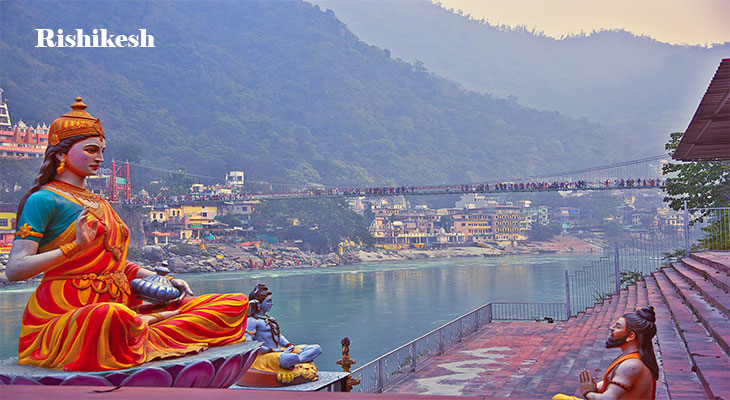
Ganga Aarti in Rishikesh : Ganga Aarti is a daily ritual performed in the evening by Hindu priests on the banks of the river Ganga in Rishikesh. This ceremony is a way to pay tribute to the holy river Ganga and seek her blessings. The Ganga Aarti involves the use of fire as a means to offer prayers and express gratitude to the river.
The ceremony usually takes place during sunset, when the priests gather on the ghats and light lamps, also known as diyas, which are floated on the river. The priests perform various rituals, including the recitation of Vedic hymns and the waving of incense sticks, which are meant to purify the surroundings and offer blessings to the devotees.
Parmarth Niketan and Triveni Ghat are among the most popular locations to witness the Ganga Aarti in Rishikesh. The Ganga Aarti at Parmarth Niketan is performed by around 50 priests who recite mantras, offer flowers, and light lamps, creating a mesmerizing ambiance. At Triveni Ghat, the Ganga Aarti is performed with diyas on the ghats, and the chanting of mantras creates a spiritual atmosphere.
The Ganga Aarti in Rishikesh is a unique experience that attracts thousands of devotees and tourists from all over the world. The ceremony is not only a way to connect with the divine but also a way to appreciate the beauty and significance of the river Ganga, which is considered sacred in Hinduism.
DAY 11 : RISHIKESH – DELHI (200 KM / 05 HRS DRIVE)